Comprehensive Electromagnetic and Magnetic Materials Concepts for Physics Students
1/135
There's no tags or description
Looks like no tags are added yet.
Name | Mastery | Learn | Test | Matching | Spaced |
|---|
No study sessions yet.
136 Terms
What are magnetic materials?
Materials that get magnetized in a magnetic field and can create a self magnetic field in the presence of an external magnetic field.
List the important types of magnetic materials.
Diamagnetic, Paramagnetic, Ferromagnetic, Antiferromagnetic, and Ferrimagnetic materials.
What is orbital angular momentum in relation to magnetic materials?
It corresponds to permanent orbital angular magnetic dipole moments of electrons.
Define magnetic dipole.
Any two opposite magnetic poles separated by a distance 'd' constitute a magnetic dipole.
How is the magnetic dipole moment calculated?
The dipole moment is given by µm = m × l, where m is the magnetic pole strength and l is the length of the magnet.
What is magnetic flux?
The total number of magnetic lines of force passing perpendicular through a given area, measured in webers.
What does magnetic flux density (B) represent?
The number of magnetic lines of force passing through a unit area of cross-section, calculated as B = Φ/A.
Define magnetization (M).
Intensity of magnetization (M) is defined as the magnetic moment per unit volume, expressed in ampere/metre.
What is magnetic susceptibility?
A measure of the ease with which a specimen can be magnetized by the magnetizing force, defined as the ratio of magnetization produced in a sample to the magnetic field intensity.
What is magnetic permeability?
The degree to which magnetic lines of force can penetrate through a material, defined as the ratio of magnetic flux density in the sample to the applied magnetic field intensity.
What is the relationship between relative permeability (µr) and magnetic susceptibility (χ)?
The relationship is given by µr = 1 + χ.
What is Bohr magneton (µB)?
The magnetic moment produced by one unpaired electron in an atom, defined as 1 Bohr magneton = eh/4πm.
What is ferromagnetism?
A phenomenon where certain metals exhibit a high degree of magnetization, showing spontaneous magnetization even without an external magnetic field.
What are the properties of ferromagnetic materials?
They have aligned dipoles, permanent dipole moments, exhibit spontaneous magnetization, hysteresis, and lose magnetization upon heating.
What is the concept of magnetic domains?
Regions in ferromagnetic materials where atomic dipoles are aligned in the same direction, producing a net magnetic moment.
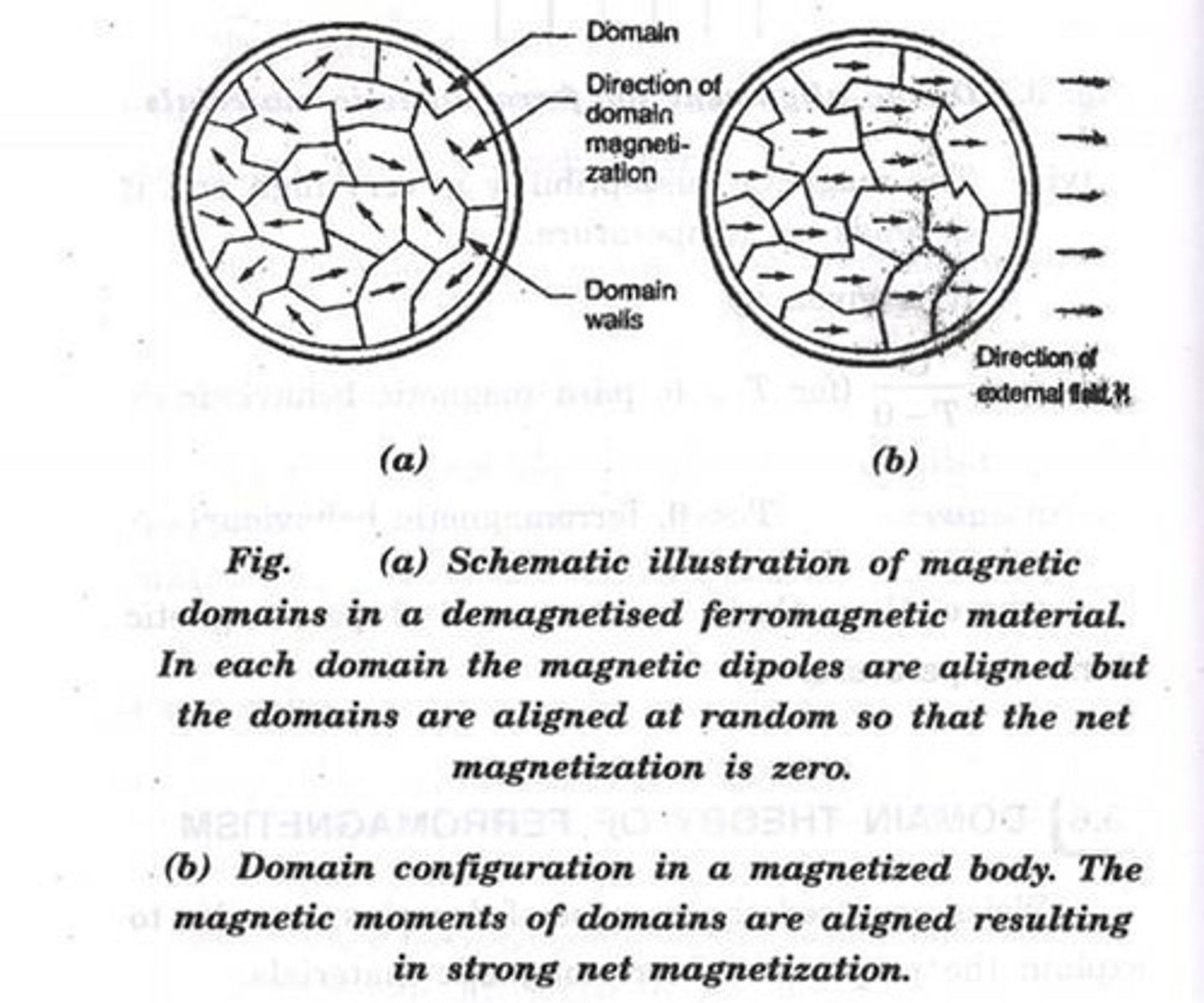
What happens to domains in a demagnetized ferromagnetic material?
The domains are randomly oriented, resulting in zero net magnetization.
How do domains align when an external magnetic field is applied?
Domains align with the field direction, resulting in large net magnetization.
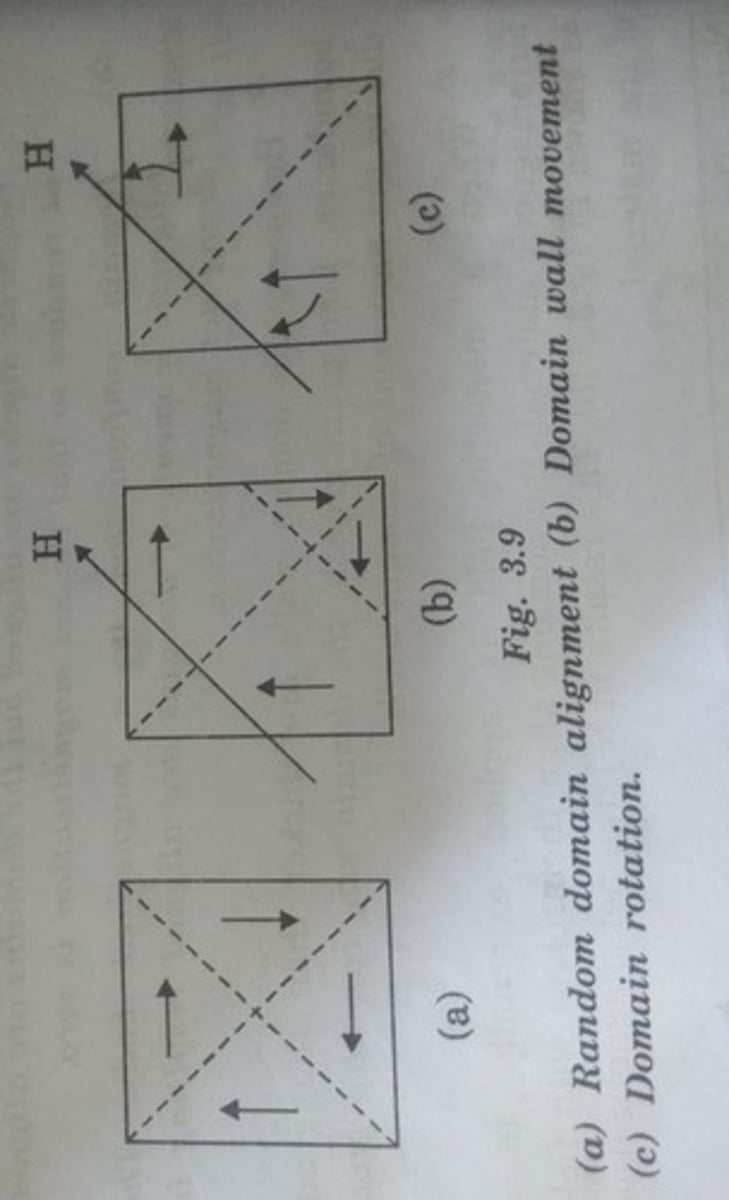
What are domain walls?
Boundaries separating magnetic domains, analogous to grain boundaries in polycrystalline materials.
Describe the process of domain magnetization.
Domains align with the external magnetic field, either through motion of domain walls or rotation of domains.
What occurs when the magnetic field is increased to a large value?
Further domain growth becomes impossible through wall movement, leading to rotation of already aligned domains for complete alignment with the field.
What causes the permanent magnetic moment in materials?
The permanent magnetic moment is mainly due to the spin magnetic moment of unpaired electrons.
What are diamagnetic materials?
Materials that do not have any permanent magnetic moment.
What types of magnetic materials have a permanent magnetic moment?
Paramagnetic, ferromagnetic, antiferromagnetic, and ferrimagnetic materials.
What are soft magnetic materials?
Materials that are easily magnetized and demagnetized, with domain walls that move easily.
What is the hysteresis loop of soft magnetic materials like?
The hysteresis loop is very steep with a small area, indicating low hysteresis loss.
List some examples of soft magnetic materials.
Iron and silicon alloys, nickel-iron alloy, iron-cobalt alloy.
What applications use soft magnetic materials?
Used in electrical equipment, magnetic cores of transformers, and high-frequency devices.
What defines hard magnetic materials?
Materials that are difficult to magnetize and demagnetize, with a high coercivity.
What is the hysteresis loop of hard magnetic materials like?
The hysteresis loop is broad with a large area, indicating high hysteresis loss.

List some examples of hard magnetic materials.
Carbon steels, tungsten steel, chromium steel, alnico.
What applications use hard magnetic materials?
Used in magnets for toys, compass needles, and certain types of meters.
What is hysteresis in magnetic materials?
The lagging of magnetization behind the magnetizing force.
What does the term 'coercive force' refer to?
The amount of magnetizing force required to completely demagnetize a core.
What is the energy product in magnetic materials?
The product of retentivity (Br) and coercivity (Hc), representing the maximum energy stored.
What is the significance of high energy product in permanent magnets?
A high energy product indicates a strong permanent magnet capable of storing more energy.
How are soft magnetic materials prepared?
By heating pure materials to allow atomic movement into an ordered lattice, followed by slow cooling.
How are hard magnetic materials prepared?
By heating and then rapidly cooling them, often with impurities introduced to enhance hardness.
What is the relationship between magnetic susceptibility and hysteresis loss in soft magnetic materials?
Soft magnetic materials have high susceptibility and low hysteresis loss due to their steep hysteresis loop.
What is the relationship between magnetic susceptibility and hysteresis loss in hard magnetic materials?
Hard magnetic materials have low susceptibility and high hysteresis loss due to their broad hysteresis loop.
What are the effects of impurities in hard magnetic materials?
Impurities increase coercivity and retentivity, making them harder to magnetize.
What is the significance of the hysteresis area in magnetic materials?
The area represents energy loss during magnetization and demagnetization cycles.

What is the typical resistivity of soft magnetic materials?
Soft magnetic materials have high resistivity, leading to low eddy current loss.
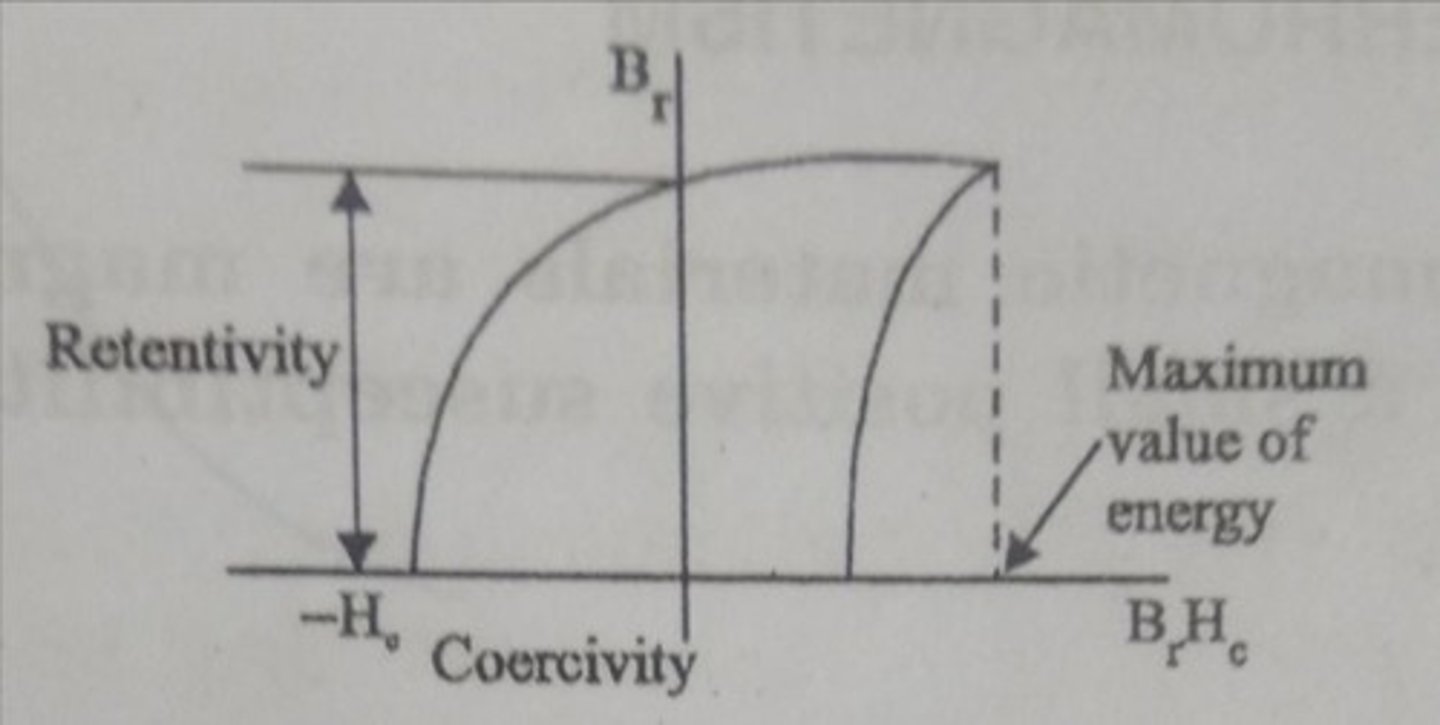
What is the typical resistivity of hard magnetic materials?
Hard magnetic materials have low resistivity, resulting in high eddy current loss.
What is the relative permeability of the paramagnetic material in the given calculation?
1.01
What is the formula to calculate magnetization (M) in a magnetic field?
M = H(µr - 1)
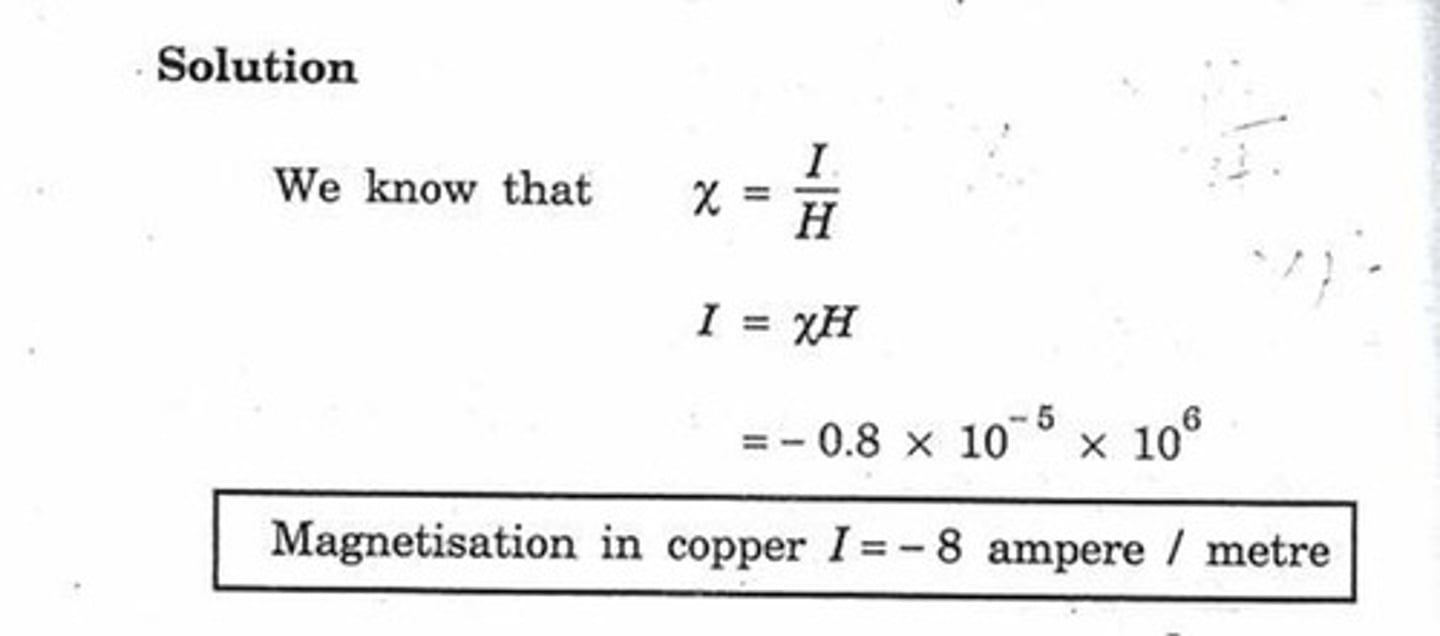
What is the formula to calculate magnetic flux density (B)?
B = µ0(M + H)

What is the susceptibility (χ) of ferrimagnetic materials represented by?
χ = C / (T ± θ)
What happens to ferrimagnetic materials when T < TN?
They behave as ferrimagnetic materials.
What are the mechanical properties of ferrimagnetic materials?
They have low tensile strength and are brittle and soft.
What is the resistivity of ferrites?
High resistivity of 10^11 Ω m.
How are ferrites manufactured?
By powder metallurgical process involving mixing, compacting, sintering at high temperatures, and age hardening in magnetic fields.
What are the two types of structures in ferrites?
Regular spinel and inverse spinel structures.
In a regular spinel structure, what occupies the tetrahedral and octahedral sites?
Each divalent metal ion occupies 1 tetrahedral site and each trivalent metal ion occupies 1 octahedral site.
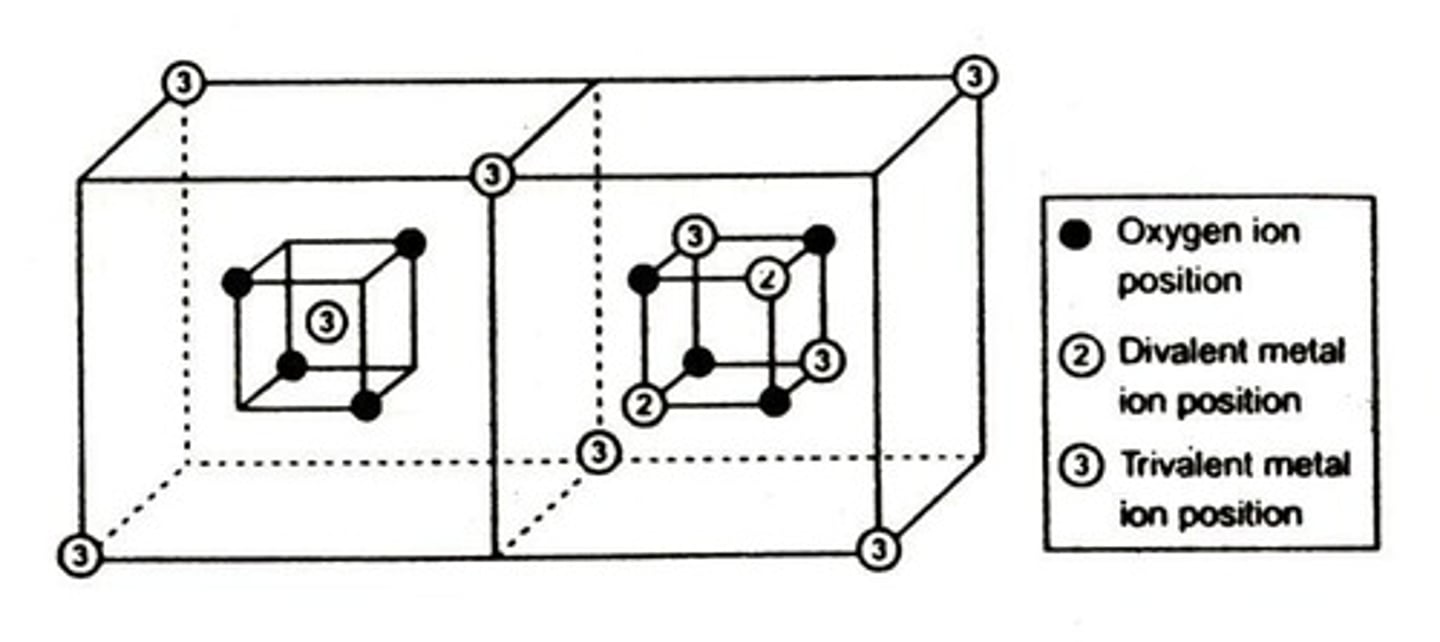
What is the general chemical formula of a ferrite molecule?
M2+Fe2+3O4
What is the arrangement of oxygen ions in a ferrite crystal?
They constitute a close packed face-centered cubic structure.
What is the magnetic moment of Fe2+ and Fe3+ ions?
Fe2+ has a moment of 4µB, and Fe3+ has a moment of 5µB.
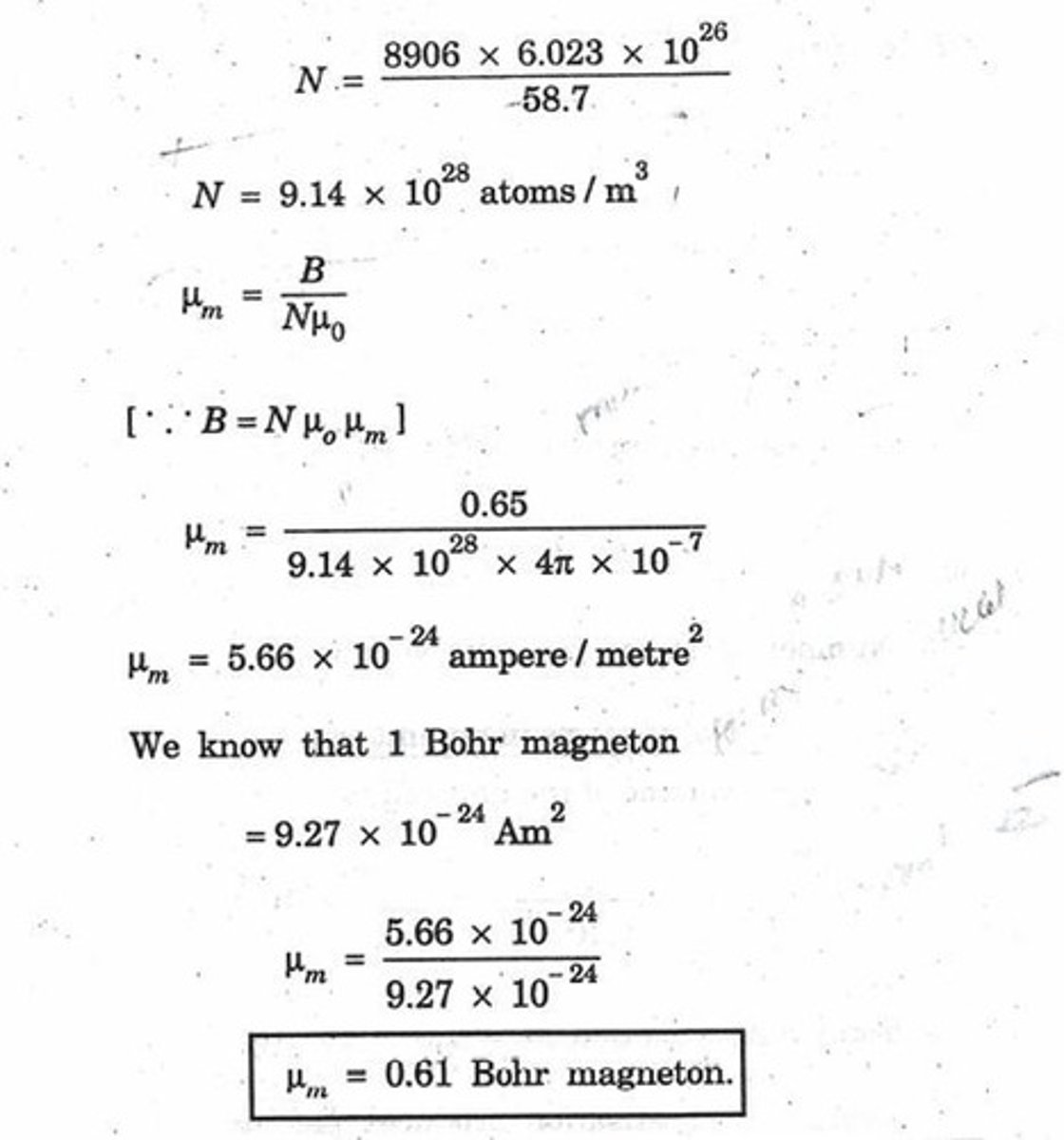
What is the significance of anti-parallel alignment in inverse spinel structures?
It confirms the anti-parallel alignment of dipoles in ferrites, aligning with experimental values.
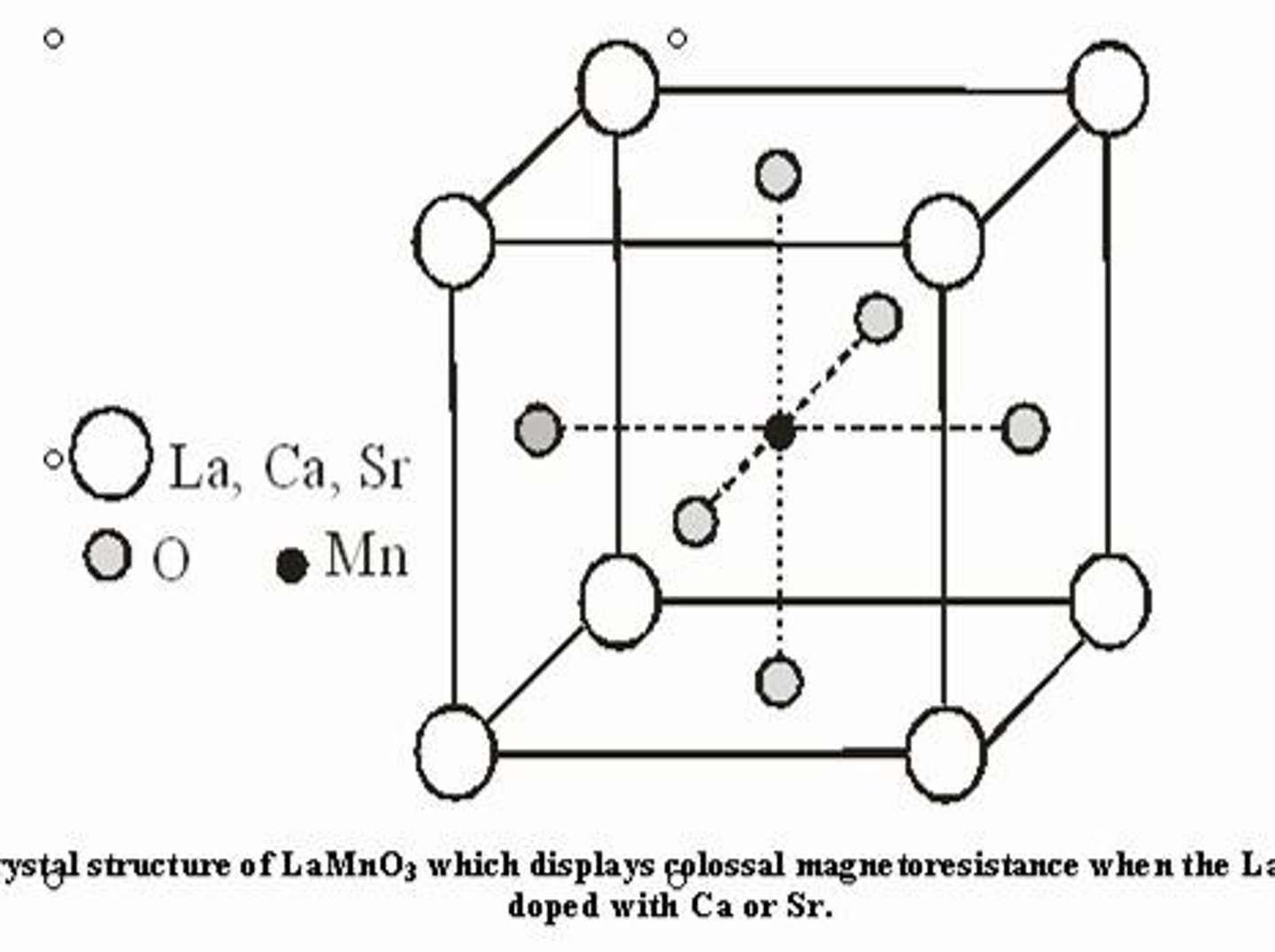
Name one application of ferrites.
Used in radio receivers to increase sensitivity and selectivity.
What is a magnetic bubble?
A tiny movable magnetized cylindrical volume in a thin magnetic material that can represent a bit of information.
What effect does an external magnetic field have on magnetic bubbles?
It flips the domains to one preferred orientation.
What is the Faraday effect?
The rotation of the plane of polarization of a light beam by a magnetic field.
What is the typical thickness of the Ferromagnetic Garnet used in magnetic bubble devices?
8-12 μm.
What happens to the serpentine patterns of magnetic bubbles when an external magnetic field is applied?
The patterns gradually disappear, and isolated magnetic bubbles may be formed.
How can magnetic bubbles be used in memory devices?
By lining up tiny electromagnets with detectors to form a series of loops that hold information.
What is the role of polarized light in the observation of magnetic bubbles?
It interacts with the magnetic field of the domains, causing the light to appear dark or bright based on the domain orientation.
What is bubble memory?
A non-volatile memory device that uses tiny electromagnets to store information in the form of bubbles, which can be pushed along a surface.
What are the advantages of bubble memory compared to traditional magnetic storage?
Bubble memory offers low access time, small physical size, low user entry cost, no maintenance, and higher reliability.
How does bubble memory maintain information when power is removed?
The bubbles remain intact, similar to patterns on a disk drive, allowing data retention without power.
What is a significant disadvantage of bubble memory?
The speed of accessing data is slower because bubbles must cycle to the far end of the sheet before being read.
What is the primary application of magnetic bubble memories?
They are used in distributed process systems requiring high-density mass storage at low cost.
What are the key properties of magnetic thin films?
Thin films have lower resistivity, high magnetic saturation induction, higher optical absorption, higher saturation flux density, and lower hysteresis loss.
What are the common techniques for fabricating magnetic thin films?
Techniques include physical vapor deposition (PVD), chemical vapor deposition (CVD), electrochemical deposition, thermal spraying, and electro-surfacing.
What is the most important deposition technique for magnetic thin films?
Sputtering (PVD) is the most significant technique used for fabricating magnetic thin films.
What are some applications of magnetic thin films?
Applications include magneto-optic devices, sensor elements, magnetic transducers, audio/video/computer memories, and magnetic read/write heads.
What is spintronics?
A new class of semiconductor electronics that utilizes the spin degree of freedom of electrons to process electronic data.
What is the giant magnetoresistance (GMR) effect?
A phenomenon that allows for increased storage density in hard drives, recognized with a Nobel Prize in Physics in 2007.
What are the advantages of spintronic devices?
Enhanced functionality, higher speed, and reduced power consumption compared to traditional electronic devices.
What materials are being researched for spintronic devices?
Materials include carbon nanotubes, graphene, topological insulators, and organic semiconductors.
How does the thickness of a magnetic thin film affect its magnetic properties?
The thickness can influence domain structure and magnetization, with thinner films often exhibiting in-plane magnetization.
What is the significance of the domain structure in magnetic thin films?
Domain structures affect the magnetic properties and are crucial for applications in magneto-optical technologies.
What is the role of sputtered materials in thin film growth?
Sputtered materials condense on the target surface to form thin films, influenced by various surface events during the process.
What is the impact of magnetic bubble memories on industrial applications?
They provide reliable memory solutions for numerical control machines and various types of process control.
Why are magnetic bubble memories considered reliable in harsh environments?
They are less affected by shock, vibration, dirt, and dust compared to electromechanical magnetic memories.
What is the primary benefit of using magnetic thin films in data recording?
They are used extensively for their advantageous magnetic properties in data storage and retrieval applications.
What is the relationship between the electron spin and energy consumption in spintronics?
Manipulating electron spins can be done faster and with lower energy costs compared to charge-based electronics.
What are the characteristics of ferro and ferrimagnetic films used in magnetic thin films?
Ferro films are typically transition-metal alloys, while ferrimagnetic films contain transition metals and rare earths.
What is one of the main challenges of using magnetic bubble memory?
The slower speed of data access compared to other memory types due to the need for bubbles to travel across the surface.
What is the significance of non-volatility in bubble memory?
Non-volatility means that data is retained even when power is lost, making it suitable for various applications.
What significant recognition did the field of spintronics receive in 2007?
A Nobel Prize for Physics.
What are some materials currently researched for spintronics devices?
Carbon nanotubes, graphene, topological insulators, and organic semiconductors.
What is Giant Magnetoresistance (GMR)?
A quantum mechanical effect observed in thin film structures of alternating ferromagnetic and nonmagnetic metal layers, leading to decreased electrical resistance in a magnetic field.
How does the magnetization of ferromagnetic layers behave in GMR without an applied magnetic field?
The magnetization is antiparallel due to weak anti-ferromagnetic coupling.
What happens to resistance in GMR when the magnetization of adjacent layers aligns due to an external magnetic field?
The resistance decreases as the magnetization aligns parallel.
What is the relationship between electron spins and resistance in GMR?
Electrons align parallel or antiparallel with the magnetic field, affecting magnetic scattering and resistance.
What is Tunnel Magnetoresistance (TMR)?
A quantum mechanical effect where conductance varies based on the alignment of two ferromagnets separated by an insulator.
What is the significance of the parallel and antiparallel states in TMR?
In parallel, tunneling current is larger; in antiparallel, tunneling current is smaller due to spin orientation mismatches.
What model explains TMR and its assumptions?
Julliere's model, which assumes conservation of electron spin during tunneling and independent conductance for spin channels.
What is Colossal Magnetoresistance (CMR)?
A property of certain materials that dramatically changes electrical resistance in the presence of a magnetic field.
How does the magnetoresistance of CMR compare to conventional materials?
CMR can demonstrate resistance changes by orders of magnitude, while conventional materials change by up to 5%.
What materials predominantly exhibit CMR?
Manganese-based perovskite oxides.